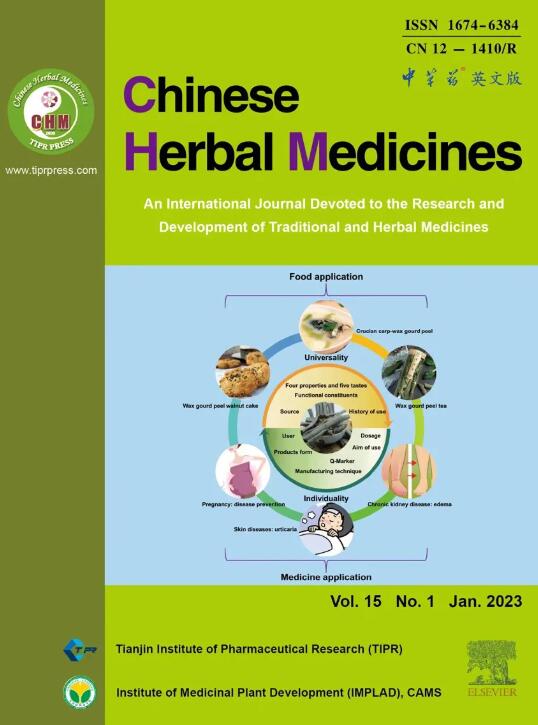MYB多态性分子标记:一种新的柑橘真伪及产地鉴定分子标记
IF 4.7
4区 医学
Q1 CHEMISTRY, MEDICINAL
引用次数: 0
摘要
目的网状柑橘(Citrus Reticulatae Pericarpium, CRP)是我国应用最广泛的中药之一,具有很高的药用、食疗和收藏价值。‘ Chachi ’(柑桔)产自广东新会的Chachiensis是CRP的地草本植物。市场上新辉CRP经常被假冒为其他品种或产地,分子鉴定方法可以有效区分不同的CRP品种,但对不同产地的同一CRP品种进行鉴定仍然是一个难题。为保证新会CRP的安全有效应用,有必要发现新的分子标记物。方法选择研究最多的柑橘属转录因子家族之一MYB,在保守区设计特异性候选引物。筛选条带重复性好、多态性高的引物对试验材料进行PCR扩增,计算不同科、属、种、来源间的遗传相似系数。聚类分析采用算术平均的非加权对群法(UPGMA)。结果共筛选到10条MYB引物,可用于鉴定不同科(人参、桑葚)、属(花椒、花椒)、种(柑桔、中华柑橘、大黄柑)植物的新会CRP。此外,从10个引物中发现两个引物M1和M10可以将新会CRP与其他来源区分开来。不同科、属、种、源鉴定的多态性条带分别为169、113、133和134条,多态性比率分别为79.88%、76.87%、79.20%和82.84%。此外,M1是鉴定新会CRP的最佳引物,基于遗传相似系数的聚类分析结果与地理分布一致。结论本研究建立了一种新的基于MYB转录因子的分子鉴定方法,可以分析CRP种质的潜在亲本关系,并对新会CPR的质量和来源进行鉴定。本文章由计算机程序翻译,如有差异,请以英文原文为准。
MYB polymorphism molecular marker: A novel molecular marker for authenticity and geographical origin identification of Citri Reticulatae Pericarpium
Objective
Citri Reticulatae Pericarpium (Chenpi, CRP) is one of the most used traditional Chinese medicines with great medicinal, dietary and collection values, among which the Citrus reticulata cv. ‘Chachi’ (Citrus reticulata cv. Chachiensis) from Guangdong Xinhui is the geoherb of CRP. Xinhui CRP in the market was often counterfeited with other varieties or origins, molecular identification method can effectively distinguish different CRP varieties, but it’s still a difficult problem to identify the same CRP variety from different origin. It is necessary to discover a new molecular marker to ensure the safe and effective application of Xinhui CRP.
Methods
We selected one of the most studied transcription factor families in Citrus genus, MYB, to design the specific candidate primers on the conserved region. The primers with good band repeatability and high polymorphism were screened for PCR amplification of the test materials, and the genetic similarity coefficient among different families, genera, species, and origins were calculated. The cluster analysis was performed by unweighted pair group method using arithmetic average (UPGMA).
Results
A total of ten MYB primers were screened out to identify Xinhui CRP from plants from different family (Panax ginseng and Morus alba), genus (Clausena lansium and Zanthoxylum schinifolium), and species (Citrus reticulata, C. sinensis and C. maxima). Furthermore, two from the ten primers, M1 and M10, were found to distinguish Xinhui CRP from other origins. There were 169, 113, 133 and 134 polymorphic bands in the identification of different families, genera, species, and origins respectively, and the accordingly polymorphism ration were 79.88%, 76.87%, 79.20% and 82.84%. Moreover, M1 was discovered to be the best primer to identify Xinhui CRP from other seven origins, the cluster analysis results based on the genetic similarity coefficients were consistent with the geographical distribution.
Conclusion
This study established a novel molecular identification method according to MYB transcription factor, which can analyze the potential parental relationship of CRP germplasm, as well as identify the quality and origins of Xinhui CPR.
求助全文
通过发布文献求助,成功后即可免费获取论文全文。
去求助
来源期刊

Chinese Herbal Medicines
CHEMISTRY, MEDICINAL-
CiteScore
4.40
自引率
5.30%
发文量
629
审稿时长
10 weeks
期刊介绍:
Chinese Herbal Medicines is intended to disseminate the latest developments and research progress in traditional and herbal medical sciences to researchers, practitioners, academics and administrators worldwide in the field of traditional and herbal medicines. The journal's international coverage ensures that research and progress from all regions of the world are widely included.
CHM is a core journal of Chinese science and technology. The journal entered into the ESCI database in 2017, and then was included in PMC, Scopus and other important international search systems. In 2019, CHM was successfully selected for the “China Science and Technology Journal Excellence Action Plan” project, which has markedly improved its international influence and industry popularity. CHM obtained the first impact factor of 3.8 in Journal Citation Reports (JCR) in 2023.
 求助内容:
求助内容: 应助结果提醒方式:
应助结果提醒方式:


